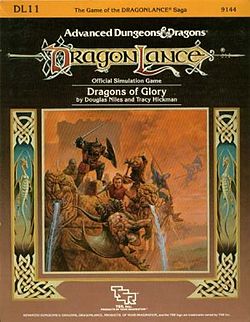- Dragons of Glory
-
Dragons of Glory 
Code DL11 Rules required AD&D (1st Edition) Character levels NA Campaign setting Dragonlance Authors Michael Dobson First published 1985 Linked modules DL1, DL2, DL3, DL4, DL5, DL6, DL7, DL8, DL9, DL10, DL11, DL12, DL13, DL14, DL15, DL16 Dragons of Glory is a Dungeons & Dragons source book that is part of the series of Dragonlance modules. It is one of the 16 DL modules published by TSR between 1984 and 1986. Its cover features a painting by Jeff Easley of Tasslehoff Burrfoot fighting a Draconian.
This module is "a complete and self-contained simulation game" centered on the War of the Lance. While the other modules focused on the journeys of the characters such as Tanis Half-Elven, this module helps the DM recreate the larger battles. Characters can control the forces of the High Solamnic Knights vs. the Dragon Highlords. This module can be played with the Battlesystem rules, but is designed to be run as a standalone wargame. Advanced rules are available in Dragon Magazine issue# 107.
Contents
Contents
The Dragons of Glory pack consists of a stiff double cardboard cover with tables and text on the inside for use in the game, a large two-sectioned map covering the continent of Ansalon and its surrounding islands, 400 die-cut counters with a re-sealable plastic bag in which to store them, an 8-page rulebook, and a 16-page campaign/scenario book.[1]
Plot summary
Dragons of Glory is a sourcebook as well as a strategic-level board wargame which depicts the overall war between the draconians and the defenders of Krynn. The set describes the war and the opposing armies, using Battlesystem statistics for both sides.[2] It includes a map, counters, and rules for playing the War of the Lance as a boardgame.[2]
Dragons of Glory is a simulation game, designed to allow players to produce their own historical timeline of the events in the world of Krynn for an ongoing Dragonlance campaign. By keeping a record of forces' positions over time, news can be related to the player characters, who can encounter various armies, creatures, or leaders at appropriate points.[1]
Publication history
DL11 Dragons of Glory was written by Douglas Niles and Tracy Hickman, awith a cover by Jeff Easley, and illustrations by Diana Magnuson and Jeff Butler, and was published by TSR in 1986 as a 16-page pamphlet, an 8-page pamphlet, two large color maps, a cardboard counter sheet, a small zip-locked bag, and a double-thick outer folder.[2]
Reception
Graham Staplehurst reviewed Dragons of Glory for White Dwarf #78. Staplehurst thought that the game "isn't brilliant", calling the rulebook "rather unhelpful", and feeling that TSR (having purchased SPI) "could have put this together rather better".[1] He felt the explanation for the counters was poor, with no key to identify which color represented which nation; he also noted that the game required multiple types of dice, making the game mechanics messy. He considered the rules "very simple and anyone who has played a simulation game before should find them easy in the extreme to pick up, though there are unclear points, which is again unnecessary in a game this simple".[1] To back up his assertion, he cited the example rules of retreating before combat, and the "moving capital" rule: he noted that with the latter rule all a player has to do to win one of the offered scenarios is "disband" their capital, and he felt that while the retreating rule was a sensible option, it left the options for the attacker unclear. Staplehurst felt that the game "didn't appeal to me as a simulation gamer", and that compared with "excellent fantasy games" such as White Bear, Red Moon and SPI's War of the Ring, Dragons of Glory seemed "to have been rather hastily put together and the rules and charts could have been much better organized".[1] Staplehurst also believed that while the option of using the simulation to provide a unique historical background and context for a Dragonlance campaign sounded fine, this would require a large amount of book-keeping and a very dedicated GM to manage; also, with ten modules already released in the series, he surmised that most players had started their campaigns already. Staplehurst concluded the review by stating, "Overall, I hesitate to recommend this game to anyone but the Dragonlance fanatic who has had some experience of simulation games. It's not a very good introduction for the novice ... and is not a particularly enjoyable [sic] to the shelves of a simulation wargamer."[1]
References
Categories:- 1986 books
- Dragonlance
- Dungeons & Dragons modules
Wikimedia Foundation. 2010.
